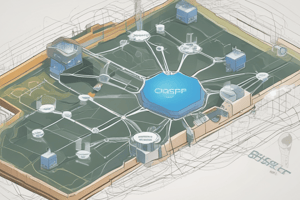Podcast
Questions and Answers
What information is contained in a Hello packet?
What information is contained in a Hello packet?
- Dead interval, router priority, and IP address assignments
- Router ID, network traffic load, and router statistics
- Router ID, area ID, and network mask (correct)
- OSPF version, Hello interval, and link status
Which state is NOT part of the OSPF convergence process?
Which state is NOT part of the OSPF convergence process?
- Routing state (correct)
- Full state
- Two-way state
- Exchange state
What does a router do upon receiving a Hello packet from an OSPF neighbor?
What does a router do upon receiving a Hello packet from an OSPF neighbor?
- Checks its own router ID for discrepancies
- Ignores the packet if the router ID is not in its neighbor list
- Sends an acknowledgment back to the sender
- Establishes an adjacency with the initiating router (correct)
Why is the election of DR and BDR necessary in a multiaccess network?
Why is the election of DR and BDR necessary in a multiaccess network?
What is the reserved multicast address used by OSPF for Hello packets?
What is the reserved multicast address used by OSPF for Hello packets?
What is the primary best practice for single-area OSPF implementation?
What is the primary best practice for single-area OSPF implementation?
In multiarea OSPF, what is the purpose of Area Border Routers (ABRs)?
In multiarea OSPF, what is the purpose of Area Border Routers (ABRs)?
Which of the following is NOT an advantage of using multiarea OSPF?
Which of the following is NOT an advantage of using multiarea OSPF?
Why are routing tables smaller in multiarea OSPF?
Why are routing tables smaller in multiarea OSPF?
What happens to the impact of a topology change within an area in multiarea OSPF?
What happens to the impact of a topology change within an area in multiarea OSPF?
Which of the following statements about multiarea OSPF is true?
Which of the following statements about multiarea OSPF is true?
Which characteristic of multiarea OSPF reduces memory requirements?
Which characteristic of multiarea OSPF reduces memory requirements?
What is the default state of route summarization in multiarea OSPF?
What is the default state of route summarization in multiarea OSPF?
Which of the following is a feature of single-area OSPF?
Which of the following is a feature of single-area OSPF?
When designing a multiarea OSPF network, what is a desired outcome?
When designing a multiarea OSPF network, what is a desired outcome?
Which packet type is primarily used to discover neighboring routers in OSPF?
Which packet type is primarily used to discover neighboring routers in OSPF?
What is the purpose of OSPF routing protocol messages?
What is the purpose of OSPF routing protocol messages?
Which OSPF database contains a list of all neighbor routers?
Which OSPF database contains a list of all neighbor routers?
How many types of packets are used in OSPF to convey routing information?
How many types of packets are used in OSPF to convey routing information?
What command can be used to view the list of neighbor routers in OSPF?
What command can be used to view the list of neighbor routers in OSPF?
What do routing algorithms process within OSPF?
What do routing algorithms process within OSPF?
Which of the following is NOT a type of OSPF packet?
Which of the following is NOT a type of OSPF packet?
What does the link-state database (LSDB) represent in OSPF?
What does the link-state database (LSDB) represent in OSPF?
What happens when a router has more current link information in the DBD?
What happens when a router has more current link information in the DBD?
What triggers the sending of LSUs in OSPF?
What triggers the sending of LSUs in OSPF?
Why is the election of a Designated Router (DR) necessary in a multiaccess network?
Why is the election of a Designated Router (DR) necessary in a multiaccess network?
What is a consequence of creating multiple adjacencies in OSPF on Ethernet networks?
What is a consequence of creating multiple adjacencies in OSPF on Ethernet networks?
What is one challenge posed by extensive flooding of LSAs?
What is one challenge posed by extensive flooding of LSAs?
How does OSPF handle LSA flooding in multiaccess networks?
How does OSPF handle LSA flooding in multiaccess networks?
What might happen if OSPF routers flood LSAs without a DR in a large multiaccess network?
What might happen if OSPF routers flood LSAs without a DR in a large multiaccess network?
How often does OSPF send LSUs aside from when changes occur?
How often does OSPF send LSUs aside from when changes occur?
What problem can arise from every router flooding LSA updates in a multiaccess Ethernet network?
What problem can arise from every router flooding LSA updates in a multiaccess Ethernet network?
What is the role of the Link-State Database (LSDB) in OSPF?
What is the role of the Link-State Database (LSDB) in OSPF?
What is the purpose of the ExStart state in OSPF operation?
What is the purpose of the ExStart state in OSPF operation?
What happens during the Loading state in OSPF operation?
What happens during the Loading state in OSPF operation?
How is a router identified in OSPF?
How is a router identified in OSPF?
What action does a router take upon receiving a Hello packet with an unknown router ID?
What action does a router take upon receiving a Hello packet with an unknown router ID?
What multicast address is used for sending Hello packets in OSPF?
What multicast address is used for sending Hello packets in OSPF?
Which OSPF state indicates that the link-state database is fully synchronized?
Which OSPF state indicates that the link-state database is fully synchronized?
What is indicated by the transition to the Full state in OSPF?
What is indicated by the transition to the Full state in OSPF?
What does LSR stand for in OSPF communication?
What does LSR stand for in OSPF communication?
What is typically exchanged during the DBD packet exchange phase?
What is typically exchanged during the DBD packet exchange phase?
Which OSPF state follows immediately after the ExStart state if more router information is needed?
Which OSPF state follows immediately after the ExStart state if more router information is needed?
Flashcards are hidden until you start studying
Study Notes
OSPF Overview
- OSPF (Open Shortest Path First) utilizes link-state information, including network prefix, prefix length, and cost for routing decisions.
- Designed for efficient and scalable routing, OSPF can be applied in single-area and multi-area configurations.
OSPF Message Types
- OSPF exchanges routing information through five packet types:
- Hello Packet: Establishes neighbor relationships.
- Database Description Packet: Initiates the database synchronization process.
- Link-State Request Packet: Requests additional routing information.
- Link-State Update Packet: Contains updates about routing changes.
- Link-State Acknowledgment Packet: Confirms receipt of updates.
OSPF Databases
- OSPF maintains three critical databases:
- Neighbor Table: Lists all neighbors with which a router has established connections. Unique to each router and viewable via the
show ip ospf neighborcommand. - Link-State Database (LSDB): Represents the network topology. All routers in an area share identical LSDBs.
- Neighbor Table: Lists all neighbors with which a router has established connections. Unique to each router and viewable via the
OSPF Area Structure
- Single-Area OSPF: All routers are part of one area, typically area 0.
- Multi-Area OSPF: Involves multiple areas connected to a backbone area (area 0). Routers connecting these areas are known as Area Border Routers (ABRs).
Advantages of Multi-Area OSPF
- Smaller routing tables due to address summarization between areas.
- Reduced link-state update overhead and processing requirements by confining changes within individual areas.
- Decreased frequency of Shortest Path First (SPF) calculations, localizing the impact of topology changes.
OSPF Operational States
- ExStart State: Routers initialize DBD packet exchange.
- Loading State: Routers retrieve additional routing information using Link-State Requests (LSRs) and Link-State Updates (LSUs).
- Full State: Indicates complete synchronization of link-state databases between routers.
Establishing Neighbor Adjacencies
- OSPF uses Hello packets sent to the multicast address 224.0.0.5 to identify neighbors. The router ID, a unique 32-bit number, is critical in this process.
- If a router receives a Hello packet from a new neighbor, it attempts to establish an adjacency.
Importance of DR in OSPF
- Multiaccess networks face challenges such as excessive LSA flooding and multiple adjacencies.
- Designated Routers (DR) minimize LSA flooding by centralizing LSA collection and distribution among routers on the same network.
Summary of Key OSPF Concepts
- Hello packets contain important fields like router ID, area ID, network mask, and intervals.
- OSPF transitions through states from down to full during neighbor discovery and data exchange.
- The need for DRs and backup DRs (BDRs) arises due to increased LSA traffic in multiaccess networks, ensuring efficient communication.
Studying That Suits You
Use AI to generate personalized quizzes and flashcards to suit your learning preferences.




